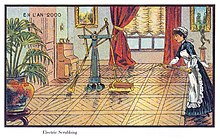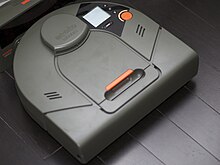Robotic vacuum cleaner

 Clash Royale CLAN TAG#URR8PPP
Clash Royale CLAN TAG#URR8PPP

A robot cleaner
A robotic vacuum cleaner, often called a robovac, is an autonomous robotic vacuum cleaner which has intelligent programming and a limited vacuum cleaning system. The original design included manual operation via remote control and a "self-drive" mode which allowed the machine to clean autonomously without human control. Some designs use spinning brushes to reach tight corners. Others include a number of cleaning features (mopping, UV sterilization, etc.) along with the vacuuming.[citation needed]
Contents
1 History
2 Models
2.1 iRobot: Mopping Scooba
2.2 Sweeping and Mopping Braava
3 Main features
3.1 Health
3.2 Cleaning modes
3.3 Wet Mopping
3.4 Antidrop
3.5 Anti-winding
3.6 Antitwining
3.7 Mapping
3.8 Virtual No-Go Lines
3.9 Quick Recharge
3.10 D-Shape
3.11 Schedule
3.12 Connected App
3.13 Software Upgrades
4 Prices
5 See also
6 References
7 External links
History

1899 Drawing of an electrical floor cleaner
In 1996, Electrolux introduced the first “Robotic Vacuum Cleaner”. The early robotic vacuum cleaners worked well but had frequent problems with colliding with objects and stopping short of walls and other objects, as well as leaving small areas not cleaned. As a result, the original product failed in the market and was discontinued.[1]
In 2002, iRobot, an American advanced technology company, launched the Roomba.[2] The Roomba was able to change direction when it encountered an obstacle, detect dirty spots on the floor, and detect steep drops to keep it from falling down stairs. It became popular very fast, which then caused other companies to reconsider the idea of a robotic vacuum cleaner.[citation needed]
An advantage using a Robotic Vacuum Cleaner is how quiet it is compared to regular vacuum cleaners. Also, they are more convenient to use due to the fact it can vacuum on its own. Not to mention the size difference, the robotic vacuum can be kept under beds, desks, closets, whereas a regular vacuum cleaner requires a large amount of space. With all positives, negatives follow. One downfall to a robotic vacuum cleaner is that it takes a longer amount of time to vacuum an area due to how small it is. They are also relatively expensive, starting at $50.00 all the way to $1,800.00.[3]

A cleaning robot as seen from below.
The first robot cleaner to be put into production was Electrolux Trilobite by the Swedish household and professional appliances manufacturer, Electrolux. Electrolux was successful in purchasing the model from its inventor, James Dizon. In 1996, one of Electrolux's first versions of the Trilobite vacuum was featured on the BBC's science program, Tomorrow's World.[4]
In 2001, the British technology company Dyson built and demonstrated a robot vacuum known as the DC06. However, due to its high price, it was never released to the market.[5]
In 2002, the American advanced technology company, iRobot launched the Roomba floor vacuuming robot. IRobot was founded in 1990 by three roboticist name Colin Angle, Helen Greiner, and Rodney Brooks.[6] The company was originally dedicated to making robots for military and domestic use. The Roomba wasn’t the first robot vacuum, but it was the most successful. Selling up to a million units in 2004. 2005 IRobot created the scooba it’s the opposite of the Roomba as it scrubs hard floors. Something that hasn’t been created before. IRobot wasn’t done their a year later in 2006 they released the dirt dog it cleaned up debris. The company wanted to make doing chores as simple as possible.[citation needed]
Initially, iRobot decided to produce 15,000 units and 10,000 more units depending on the success of the launch. The Roomba immediately became a huge consumer sensation. By the Christmas season, iRobot produced 50,000 units to meet the holiday demand. After this success, major specialty retailers, as well as more than 4,000 outlets such as Target, Kohl's and Linens 'n Things, began to carry the Roomba.[7]
Since 2002, new variations of robotic vacuum cleaners have appeared in the market.[8] For example, the Canadian bObsweep robotic vacuum that both mops and vacuums,[9] or the Neato Robotics XV-11 robotic vacuum, which uses laser-vision rather than the traditional ultrasound based models.[10]
In 2014, Dyson announced the release of its new robotic vacuum called Dyson 360 Eye, equipped with a 360-degree camera that is mounted on the top of the robot vacuum cleaner and is supposed to provide a better navigation than other brands. The robot vacuum was scheduled for a Japan-only release in spring 2015 with international launches to follow later in the year.[11] Moreover, Dyson announced that the 360 Eye has twice the suction of any other robot vacuum. Dyson is leading the robotic vacuum market towards the goals of achieving a reliable and capable unit.[12] The company is investing robotics and AI to produce better robot vacuum cleaners in the coming years. It has initiated the establishment of a new campus in the UK[13] which will require a workforce of around 7000 and an investment of £330 million to create a wider research facility in Singapore focusing on “connected technology and intelligent machines.”[14]
iRobot CEO Colin Angle claimed in 2016 that 20% of vacuum cleaners worldwide were robots.[15]
As of 2017 23% of vacuum cleaners were robots.[16][not in citation given]
As of 2018, obstacles such as dog dirt, cables and shoes remain very difficult for robots to navigate around, according to PerceptIn CEO Zhe Zhang.[17]
Models
iRobot: Mopping Scooba
The iRobot first premiered with the self-mopping robot, Scooba, in 2005.[18] The robot was made to be a self-regulating mop. The Scooba would go through many different changes through the years.Including the Scooba 450, released in 2014.[19] In 2016 iRobot discontinued the Scooba line in favor of Braava.[20] Braava has a implemented wall charger, it has no sensors and uses cotton swabs to clean instead or brushes.[21] In 2018 the Braava Jet 240 received its own app.[22] Braava sales has risen 65-percent since 2016.[23]
Sweeping and Mopping Braava
Braava 380T is a high end model of the late stages of the iRobot. The Braava 380T has the ability to do two options in the same pass, which are, sweep and mop. The device has the efficiency to hold a battery life of up to around 4 hours. iRobot Braava 380T uses an innovative technology called “North Star navigation”. The North Star in this context is a special high tech cube. The cube gives a signal which iRobot uses to position itself in the room. It will know where exactly in the room it is and which part of the floor it has mopped or swept. The manufacturer described it as a GPS system for home robots, which is a great analogy.[24]
Main features
Health
UV sterilization and HEPA filter.
Cleaning modes
Cleaning types usually include auto mode for general cleaning, scheduled mode, turbo (maximum clean), edge clean for skirting boards and corners, area cleaning mode for cleaning designated areas, spot or spiral mode for spot cleaning a particular zone, and remote mode, allowing the user to steer the robot to a particularly dirty spot.
Wet Mopping
Some models can also mop for wet cleaning, autonomously vacuuming and wet-mopping a floor in one pass (sweep and mop combo).
The water could creep to the mop gradually, does the mopping as the human beings.
A Robot Mop can tackle multi surfaces and comes with a variety of different cleaning modes giving you options of sweeping, vacuuming and mopping damp or wet floors. The Robot Mop score better on hard floors surface and are ideally suited for hardwood, laminate and tile flooring types
Antidrop
Most robots include anti-drop and anti-bump IR sensors.
Anti-winding
When approaching obstacles, will automatically revolve away.
Antitwining
Prevents the robot getting twined by wires.
Mapping

Laser robot also saves the map for future cleaning programs.
The first robovacs used random navigation. This sometimes caused the unit to miss spots when cleaning or be unable to locate its base station to recharge, and did not provide the user a history of which spaces were cleaned.
More sophisticated models include mapping ability. The unit can use gyro, camera, radar, and laser (laser distance sensor or LDS) guided systems to create a floor plan, which can be permanently stored for more efficiency. These vacuum robot has memory, knowing where has been cleaned, where has not, Thus the cleaning efficiency is greatly improved and the repetition rate is reduced significantly.
Models with a multiple floor plan feature can store several floor plans.
Virtual No-Go Lines
Virtual No-Go lines set boundaries, to restrict the unit's movements to desired cleaning areas.
Quick Recharge
The 2000 mAh Lithium battery lasts long enough to handle a big house of 200 m² (about 100 minutes).
Regular charge time is 5 to 6 hours.
Quick recharge allows the unit to calculate the shortest way to recharge (shortcut path) and charge only as much as needed, so it finishes more quickly (automatic cleaning resumption).
D-Shape

D-shape vacuum cleaner
A D-shape design can help capture dirt in corners and along walls better than some round units.
Schedule
Scheduled daily cleaning. All-Timetable means a full week of different daily schedules can be programmed.
Connected App
Some models allow control of the unit using an app over a WiFi connection, from your smartphone or connected home automation device, e.g. Amazon Alexa and the Google Assistant.
Software Upgrades
Some units are able to receive over the air (OTA) firmware updates.
Prices
Chinese robots have dropped prices, mainly in mapping robots.
See also
- Automated pool cleaner
- Comparison of domestic robots
- Domestic robots
- List of vacuum cleaners
- Mobile robot
- Open-source robotics
- Robotic mapping
- Wireless sensor network
References
^ "Invention of Robotic Vacuum Cleaners". Vacuum Cleaner History. Retrieved 2018-03-05..mw-parser-output cite.citationfont-style:inherit.mw-parser-output qquotes:"""""""'""'".mw-parser-output code.cs1-codecolor:inherit;background:inherit;border:inherit;padding:inherit.mw-parser-output .cs1-lock-free abackground:url("//upload.wikimedia.org/wikipedia/commons/thumb/6/65/Lock-green.svg/9px-Lock-green.svg.png")no-repeat;background-position:right .1em center.mw-parser-output .cs1-lock-limited a,.mw-parser-output .cs1-lock-registration abackground:url("//upload.wikimedia.org/wikipedia/commons/thumb/d/d6/Lock-gray-alt-2.svg/9px-Lock-gray-alt-2.svg.png")no-repeat;background-position:right .1em center.mw-parser-output .cs1-lock-subscription abackground:url("//upload.wikimedia.org/wikipedia/commons/thumb/a/aa/Lock-red-alt-2.svg/9px-Lock-red-alt-2.svg.png")no-repeat;background-position:right .1em center.mw-parser-output .cs1-subscription,.mw-parser-output .cs1-registrationcolor:#555.mw-parser-output .cs1-subscription span,.mw-parser-output .cs1-registration spanborder-bottom:1px dotted;cursor:help.mw-parser-output .cs1-hidden-errordisplay:none;font-size:100%.mw-parser-output .cs1-visible-errorfont-size:100%.mw-parser-output .cs1-subscription,.mw-parser-output .cs1-registration,.mw-parser-output .cs1-formatfont-size:95%.mw-parser-output .cs1-kern-left,.mw-parser-output .cs1-kern-wl-leftpadding-left:0.2em.mw-parser-output .cs1-kern-right,.mw-parser-output .cs1-kern-wl-rightpadding-right:0.2em
^ "Invention of Robotic Vacuum Cleaners". Vacuum Cleaner History. Retrieved 2018-03-05.
^ "How Robotic Vacuums Work". How Stuff Works. Retrieved 2018-03-05.
^ "BBC NEWS - Technology - Robot cleaner hits the shops".
^ Ulanoff, Lance. "Dyson Wants to Build a Robot Vacuum that Can See".
^ "the history of the roomba".
^ "How the Roomba Was Realized". 6 October 2003 – via www.bloomberg.com.
^ "What Things you must pay attention when buying vacuum cleaner robot" (in German). Retrieved 2017-05-08.
^ "VIDEO - bObsweep vs Roomba: Battle Of The Robots - Viewpoints Articles". 23 January 2014.
^ "neato robotics frees people household chores launch - Search results from HighBeam Business".
^ "Deluxe brand Dyson creates its first robot vacuum, the 360 Eye". 2014-09-04. Retrieved 2015-09-26.
^ Euro-Pro Operating LLC v. Dyson Inc., 2015 U.S. Dist. LEXIS 20558; Sharkninja Operating LLC v. Dyson Inc., 2016 U.S. Dist. LEXIS 144842
^ https://www.bbc.com/news/uk-england-wiltshire-39117982
^ https://www.ft.com/content/6a51c102-bf9c-11e6-81c2-f57d90f6741a
^ 20% of All Vacuums are Robots, 2016-11-08. Retrieved 2018-05-25.
^ "You rest, they work. Robovac complete guide".
^ Bryan Heater (2017-12-06). "PerceptIn has raised $11 million to help robotic vacuums and self-driving cars see". TechCrunch. Retrieved 2018-05-25.
^ "History | iRobot". www.irobot.com. Retrieved 2018-03-05.
^ "iRobot Invents New Wet Floor Scrubbing System". iRobot MediaKit. Retrieved 2018-03-05.
^ Daily, Investor's Business (2016-03-16). "IRobot Hopes To Clean Up In Floor-Mopping Business | Stock News & Stock Market Analysis - IBD". Investor's Business Daily. Retrieved 2018-03-05.
^ "This robotic mop will clean your home, but not without plenty of help". The Verge. Retrieved 2018-03-05.
^ "Review: iRobot Braava Jet 240 robot mop". knowtechie.com. Retrieved 2018-03-05.
^ Symington), newsfeedback@fool.com (Steve. "Why iRobot Corporation Stock Is Plummeting Today". madison.com. Retrieved 2018-03-05.
^ Bryga, Cameron. "Braava 380T". Home Robot Reviews. Home Robots.
External links
| Wikimedia Commons has media related to Robotic vacuum cleaners. |